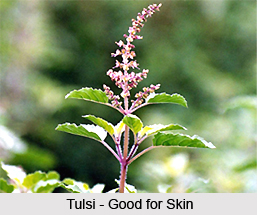 Skin diseases like, wound, blisters, cuts,itches, Hair falling, Gray hairs are the common problems, which can be cured in home with out a doctor. here are some ayurvedic treatments which are easily availabe in home.
Skin diseases like, wound, blisters, cuts,itches, Hair falling, Gray hairs are the common problems, which can be cured in home with out a doctor. here are some ayurvedic treatments which are easily availabe in home.
•If a wound is festering because of infestation with microorganisms, and blood is oozing out, wash the wound with Tulsi decoction which is just barely hot, and apply a paste of crushed Tulsi leaves.
•Dry Tulsi leaves, some alum, ground well powder can be applied on any fresh cuts or wounds, and will promote quick healing.
•If eruptions are caused by `sheetpitta` (urticaria), apply Tulsi juice over the affected areas. This should be followed by daily application of crushed Tulsi leaves mixed with black clay.
•Boils in the armpits can heal, on applying a warm poultice of Tulsi leaves, mustard seeds, jaggery and googal (mukul) ground together.
•To cure blisters, boils, furuncles, eruptions, etc take 50 gms of lemon juice in a copper vessel. Add 50 gms of Tulsi juice, and the same quantity of the juice of black kasondra. Keep the vessel in sunlight. The juices will begin to lose water by evaporation. Expose the vessel to sunlight daily till all the water is lost and a dry black residue is left. Application also improves the appearance and beautifies the face.
•White spots on the face or any other area of the skin can be cured by applying the clay adhering to the roots of a Tulsi plant on the affected parts.
•Loss or graying hair at an early age can be cured by rubbing the skin of the head vigorously with Tulsi leaves and powdered any/as (Indian gooseberry fruits). Done every day, the roots of the hair become strong and hair begins to grow and becomes black, smooth and soft.
•Itching can be soothed by taking Tulsi juice with powdered majuphal, and applying a mixture of Tulsi and lemon juice.
•Rubbing clay adhering to Tulsi roots all over the body, and taking a bath after a short time cures all skin diseases.
•The pain in the initial stages of measles, chickenpox and smallpox is alleviated by drinking the extract of Van Tulsi.
•Poison blisters washed with hot extract of Tulsi leaves.
•Organisms infesting wounds are destroyed by sprinkling finely powdered dry Tulsi
•Itching and eczema can be cured by applying a paste obtained by grinding the leaves of a Tulsi plant in lemon juice.
•The discomfort by prickly heat can be relieved by eating Tulsi seeds with five gms of anvla (Indian gooseberry) jam.



















